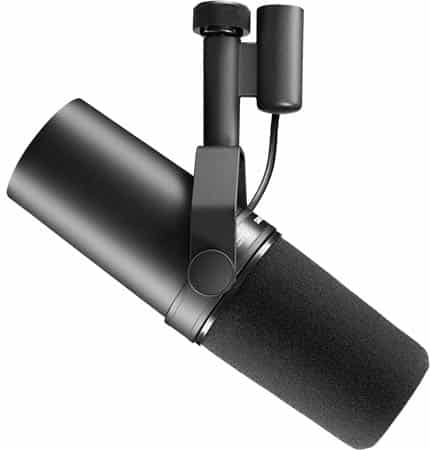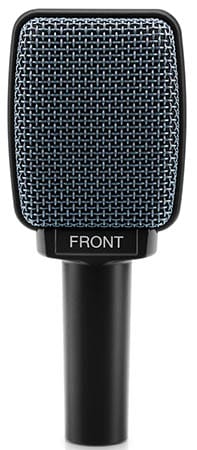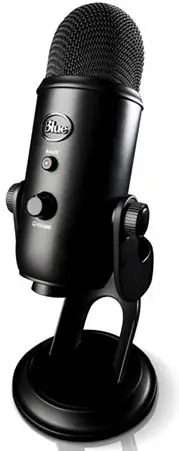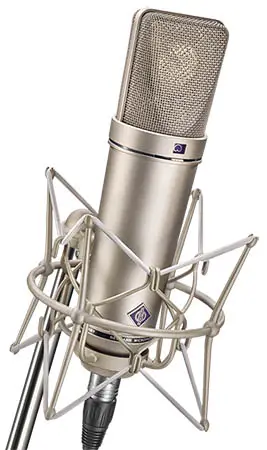Recording electric guitar can be a challenge. Electric guitar playing is incredibly diverse, and with effects pedals and a variety of different genres the same instrument can have so many different sounds. To get the most out of your electric guitar when making a recording, you have to choose the best microphone. In this article, we’re exploring the 10 best microphones for electric guitar and micing up electric guitar amps.
The process can take a little learning and there are a few different ways to record electric guitar whether you’re doing so at home or in a studio. Every engineer (whether amateur or professional) tends to come up with their own workflow and techniques over time, but this is simply not possible without having a microphone which is up to the job.
In this post, we’ve got an eye on not only dream mics with clear audio, but good budget microphones and those which offer the best value for money. Also, some mics are better for different styles and genres.
What to Consider When Choosing Your Mic
There are a number of different factors in what makes a good quality microphone. Learning a little about recording and the mechanics of microphones as well as the features on offer can help. We’ve covered the most important considerations as well as features and functionality that make certain microphones better for electric guitar than others.
Other Recording Methods
It is worth mentioning before delving fully into microphones, that there are other ways to record your guitar. We’re focusing on what many see as the most authentic sound, micing up the amplifier you use for your guitar. However, there are other ways to get the audio signal into your music software of choice and if you want to know more about the other methods then read out post here How To Record Electric Guitar (Audio Interface, Amp, Phone, PC, Mac).
For example, one of the methods we talk about in that article are Digital Interface boxes and guitar interfaces which are both ways to plug in your guitar cable directly. The ¼ inch jack goes into the interface instead of an amplifier, and this then communicates with your computer. This can be a very simple way of getting started, though the cleanest and arguably best-sounding recordings will still likely come from a microphone recording your amp.
Condenser vs Dynamic
These are two terms you’re likely to come across a lot when mic shopping! These are the two most common varieties of microphone and are named after the technology driving the recording. You may also see ribbon mics, but these are rare. So what are the differences?
A dynamic microphone is built to be more rugged, and are often used in live scenarios. In return for this extra durability, you sometimes lose a little detail. There are some brilliant dynamic mics out there, though, and some make it to our list of the top microphones for electric guitar.
Condenser microphones won’t stand up to the test of being dropped or thrown around without breaking! They need to be looked after and also require a source of power such as a mixing desk or audio interface. However, they can be extremely detailed. Many of the best mics in the world are condenser microphones, and the clarity on offer is often better than dynamic mics.
Polar Pattern
The polar pattern is a diagram of where the microphone most effectively picks up sound. Not all are the same, and different microphones have different settings. Sometimes, the polar patterns can even be altered by the user. Cardioid is the most common setting for recording electric guitar, and arguably the best. This pattern will reject the sound coming from behind the mic or from the sides and pick up most effectively what is directly in front of it.
Other patterns include omnidirectional, which picks up from all around, and figure of eight, which picks up from both front and back. These polar patterns aren’t as sound-isolating, so they will pick up more of the ambiance of the room. You can choose based on whether you want the reverb of your room to be more audible.
Max SPL
This is a feature which can be very important for recording electric guitar. SPL stands for ‘Sound Pressure Level’. This is the level of volume that the microphone can handle, measured in decibels, before it starts to distort.
Naturally, you can alter the volume of your guitar amplifier, but most guitarists like to play loudly. If you have a really sensitive mic with a low SPL then it can start to sound absolutely terrible very quickly, and you’ll end up with unusable audio. You don’t have to crank an electric guitar to get a clear recording, but an amp is usually pretty loud.
Diaphragm
The diaphragm of a mic can vary in size, and there are mics advertised as small diaphragm and mics advertised as large diaphragm. Both give slightly different results.
A small diaphragm model tends to be better when used close-up to mics, and can pick up a lot of subtle details. If this is combined with a cardioid pickup pattern then the rejection of noise coming from elsewhere in the room will be maximized.
Large diaphragm mics tend to give a good overall sound of the room as well as the instrument you’re recording. Used in a nice environment they can be good for vocals and acoustic instruments, and give a nice space to your electric guitar.
Neither is right or wrong, but you may find one type of mic more preferable.
Frequency Response and Filters
The frequency response of a microphone relates to how well it reacts and picks up certain frequencies. It is rare for a microphone not to leave its mark in some way on the sound. Some mics are able to record electric guitars in a way that brings out different aspects and characteristics. Some mics are better at picking up bass sounds and these may be preferable for certain genres, for instance if you are looking to create meaty, overdriven riffs. Alternatively, mics with a nice shine in the high end might be good for solos and melodies. The trick is knowing how to get the most out of your microphone. In truth, a good versatile mic that can pick up a lot of frequencies well is the best bet for most guitar.
Some microphones have filters, such as a high-pass filter. This will get rid of the low frequencies and only let the high pass. This is designed to leave space in the mix for low-end instruments like a bass guitar to sit nicely and be audible throughout.
Brand
We don’t believe that you should make this choice exclusively because of brand. The truth is that the best recording studios mix up a lot of different branded products. Loyalty to one brand is not necessary and there are no real reasons not to play around with multiple manufacturers. That said, certain brands carry a lot of weight in the industry and this is for a reason. Brands such as AKG, Audio-Technica, Shure and Neumann are known for their audio quality, clarity and sharpness. Other brands are known as being more budget, and usually constructed in a more cheap and flimsy way. There’s always room for affordability in a recording setup, but remember that certain brands virtually guarantee results you’ll be happy with while others present a risk.
Other Considerations – Audio Interface and Acoustics
Before buying a microphone, you should have given some thought to the method you plan to use to record and also the acoustics of the room you are recording in. Don’t record in a nasty, untreated garage which sounds echoey and horrible. The idea is to get either a great quality recording with the acoustics of a great room, or get the sound as ‘dry’ as possible. You can add effects like reverb and echo later if you need to.
Also, know that most of the microphones on this list won’t be able to produce a signal into your computer or software without some form of audio interface. An audio interface boosts and amplifies the signal and then sends it to your DAW for you to record. Unless you are using a USB mic, you will need one of these.
USB microphones aren’t necessarily out of the question, and our list of the very best microphones for guitar amp includes USB options. Though very convenient, some of the USB products on the market don’t provide quite the same level of clarity that the ‘old fashioned’ methods would. That said, being able to plug in and record in a matter of seconds is a big plus for many bedroom producers.
Best Microphone Models Reviewed
On to the best mics for electric guitar as selected by us! We’ve included not just elite, super expensive microphones, but options to suit multiple budgets. These are explained within our list, for instance, the best microphone under $100 is nominated as the Shure Sm57.
We’ve also included different features and designs, such as a mix of condenser and dynamic mics, and USB or XLR connections. This means there is likely to be an option on our list which suits the recording process you are going for. On to the list.
Shure SM57 – Best Under $100

If we had to guess which microphone has recorded more electric guitar than any other, we’d guess the SM57. This is an iconic microphone made by Shure which is incredible value for money. It is a dynamic mic and while it is not the most detailed and clear on the list, used right, the SM57 can produce some very professional results. Check here for the current price of the Shure SM57 at Amazon
The SM57 has become known for being incredibly versatile. The frequency response lends itself to a lot of different instruments and can get good recordings of acoustic guitar and electric guitar. This is also a mic which has a really robust design. It is a dynamic mic and is used in live settings all over the world.
The SM57 doesn’t need phantom power, it connects via XLR to your audio interface and comes with a clip to put onto a stand and a pouch style carry case. If you want versatility and are on a budget then it is worth considering this small and reliable mic.
Shure SM7B Cardioid Dynamic Microphone – Best Under $500

The SM7B is a microphone which can produce similar results to the SM57 with a higher fidelity and clarity. It is a larger microphone with a bigger capsule, too. The rugged construction and high SPL mean that it can handle high volume recordings and it is perfect for placing on your amp and getting some amazing guitar recordings. It is more expensive than the SM57, but the SM7B maybe has more of a place in a pro studio recording, as opposed to just live use. Check here for the current price of the Shure SM7B at Amazon.
The frequency response is really flat. This makes for top quality recordings on all sorts of different instruments. A bass rolloff (high pass filter) can also be combined with a mid-range boost. This is great for electric guitar and really lets you record meaty riffs.
The internal shock mount removes mechanical noise and interference. This is something that can be a huge issue when home recording in a space with broadband and lots of electronics. This is combined with a pop filter which makes it good for vocal recordings, too.
This isn’t the cheapest microphone out there, and is more than you would normally pay for a dynamic mic. However, it is built to be really rugged. Treated right, this can be your studio accomplice for many decades.
Rode NT4 X/Y Stereo Condenser Microphone

Stereo recordings usually involve the use of two different microphones and can give a more rounded recording with much more depth and use of both left and right audio channels. This is something a lot of beginners shy away from doing, as it can cause issues with phasing. With the NT4, you don’t need to worry as the mic is set up for you with two capsules. It is effectively two mics within one and provides gorgeous, detailed recordings. Check here for the current price of the Rode NT4 X/Y at Amazon
This is a condenser mic and needs phantom power, but for your added convenience, it can be powered with a 9v battery instead of an audio interface or desk.
This stereo recording microphone does a great job of picking up the ambiance of the room as well as the amplifier, and if you’re recording in a particularly nice acoustic space or studio then this will really shine through. The mic can also do a good job as drum overheads or for making field recordings. Sound designers love it. While it may not be necessary to get a stereo recording, it can be a very impressive thing to do if you can get it right, and the NT4 makes this much easier.
Sennheiser e906 Supercardioid Dynamic Mic – Best Under $200

Sennheiser is a brand you may have heard of from their range of headphones, which is both extensive and high-quality. They also make a huge amount of microphones and the e906 is one of their best. It makes our list because it is a brilliant quality dynamic microphone, but is especially useful for guitar amps. In fact, it is designed specifically to record electric guitars and has features to back this up. Check here for the current price of the Sennheiser e906 at Amazon
The flat design of this microphone allows it to sit snugly next to a guitar amp, and the hypercardioid polar pattern gives it the ability to reject a lot of the other audio around. It is great for both live and studio use and the recordings are always reliable.
This comes with a carry case and 10-year warranty. Incredible detail is on offer with this microphone and it has an adjustable switch to change the frequency response. The modes are bright, moderate and dark and these suit different styles of music and recording styles, giving you more control of the overall sound. You can change modes depending on whether you’re playing chords, solos or other melodies.
Sennheiser MD 421-II – Best for Sound Isolation

Some microphones take on a life of their own. Not many electronics have been in production for over 30 years with the same model, but the MD 421 is a microphone which has had decades of being an industry staple. It was initially used largely for broadcasting purposes but as time has gone on it has become very popular in studios, too. This dynamic cardioid mic is the perfect companion for your guitar amp. Check here for the current price of the MD 421 at Amazon.
This mic has a good level of versatility and a rugged capsule and design, meaning it can withstand long-term use and can record even loud audio coming from a source such as an amp.
One of the top reasons we recommend this mic is the rejection of audio from the sides and back in the cardioid pattern. This is one of the best mics ever when it comes to isolating audio from the source. It can take much of the room and ambiance out of the equation, which makes it good for getting clear and untainted audio recordings and not pick up other things in the room. This is no substitute for good acoustics, but it is a very helpful tool.
Beyerdynamic M160 – Best Ribbon Mic for Electric Guitar

A ribbon microphone can be incredibly sensitive, and they can break easily if dropped or not protected. However, the audio quality they can create for a number of different instruments is exceptionally good. The M160 is a superb option for electric guitar when it comes to detail and warmth. Check here for the current price of the Beyerdynamic M160 at Amazon.
The ribbon gives an analog feel to these recordings and a beautiful vintage warmth. The compact size is easy to mic up a guitar, just don’t blast your amp too loud as the sensitivity of this mic may lead to distorted recordings. Also, ensure you’re recording in a space with very good acoustics as these will shine through with a recording made on the Beyerdynamic mic.
It may not be the very best option for absolute beginners, and if you’re recording in an environment where the microphone might get knocked around a bit then you should go for something more robust. However, for incredible warmth and a classic, rocky guitar tone, the M160 is superb.
You will pay a little more for this than many of the other options. Ribbon mics tend to be more expensive. If the worst should happen and the ribbon should break, it isn’t too difficult to get it replaced.
AKG Pro Audio C414 XLS Instrument Condenser Microphone

This microphone is one of those to reach legendary status. The C414 has been around for decades and is one of the most versatile condenser mics out there. AKG’s build quality is always exceptional, and this is the preferred tool of choice in many studios around the world when recording acoustic guitar, electric guitar and a variety of other instruments. A C414 will likely cost over $1000 when it is brand new, but if you have the money you can guarantee an exceptional audio tool. Check here for the current price of the C414 at Amazon.
This has nine different polar patterns, making it suitable for a lot of different environments. You can experiment and choose which is best for the room you are in and the audio source.
For high volume recordings, you have attenuation settings and can cut the volume to ensure it doesn’t peak. There is also an overload warning which will tell you if it does start to overload and peak. This make it a wonderful option for electric guitars which can be easy to crank too high and overload the microphone.
Blue Yeti USB Microphone

Blue microphones have truly revolutionized USB recording. Years ago, recording with a USB mic would have been unthinkable if you wanted to get some sort of professional results. However, in the modern age it is possible, even if some audio purists aren’t keen on the technique.
The Blue Yeti is brilliant for vocals but can also do a very good job on a guitar amp too if used correctly. This is a condenser mic but due to being USB it doesn’t need any form of phantom power. Check here for the current price of the Blue Yeti at Amazon.
There are three different capsules which you can switch between and this means different recording patterns. You can use these interchangeably for the best results.
There is more risk of electrical interference by using one of these mics, but for tracking demos at home there aren’t easier or quicker ways to get set up. This is described as a microphone for the YouTube generation and it is used by many podcasters and YouTubers when making commentaries and the like. It doesn’t need any interface or to be plugged into a mixing desk to get started, and the plug and play capability is one of the biggest plus points.
Neumann U87

The Neumann U87 has been an industry standard microphone for many years, and is popular for recording vocals, but also instruments, including the electric guitar parts of songs. It is an ultra high fidelity mic and though it will set you back a fair amount of money, it is highly professional in nature. These microphones also hold their value exceptionally if you ever want to sell it on. Check here for the current price of the Neumann U87 at Amazon
This has an attenuation switch to ensure the sensitivity is lower and the mic doesn’t get overloaded. This should definitely be used when recording loudly, you don’t want to risk an expensive mic.
This is a large diaphragm condenser microphone and does a great job of picking up the acoustics and ambiance of the room in which you are recording.
For recording some demos at home to send around to friends then this might be overkill, but if you have ambitions of really professional recordings then the U87 can help.
AKG P170 – Best Cheap Mic for Electric Guitar

If you’re looking for a budget option which isn’t flimsy and still gives a good quality recording then you can buy an AKG P170 for a brilliantly affordable price, well under $100. Check here for the current price at Amazon of the AKG P170.
It has been designed to record both acoustic and electric guitars, the frequency response can bring a real shine out in these instruments and replicate the sound of your guitar just as well as some mics twice as expensive.
It has a -20dB pad which is great for louder volumes and ensuring you don’t overload it. The small diaphragm, cardioid capsule allows you to reject the sounds around the amp and isolate the sound.
While this isn’t a microphone which will challenge products like the U87 or the C414 when it comes to audio quality, but to get the rugged construction of an AKG mic with such an affordable price is a big plus.
This mic also comes with a two-year warranty. It is a great workhorse and is small enough to carry in your guitar bag.
Conclusion
The microphone you opt for should be based on your own budget as well as the features you plan to prioritize and the method you wish to use to record. Whether you’re looking for an elite model which can give professional, studi
